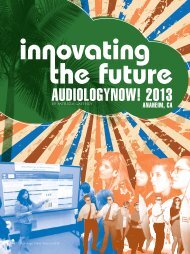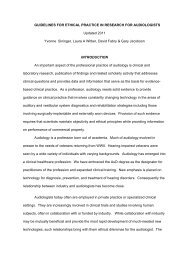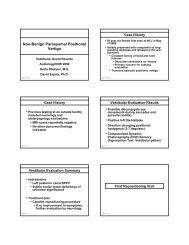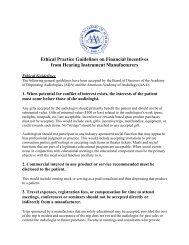Noise-Induced Hearing Loss - American Academy of Audiology
Noise-Induced Hearing Loss - American Academy of Audiology
Noise-Induced Hearing Loss - American Academy of Audiology
Create successful ePaper yourself
Turn your PDF publications into a flip-book with our unique Google optimized e-Paper software.
Assessing <strong>Hearing</strong> Protectors in the<br />
Clinic- How to Perform CPT 92596<br />
Developed in conjunction<br />
with the House Ear<br />
Institute and uses<br />
sophisticated s<strong>of</strong>tware in a<br />
user-friendly format to<br />
determine the Personal<br />
Attenuation Rating (PAR)<br />
your patient receives.<br />
The VeriPRO package<br />
consists <strong>of</strong> PC-based<br />
s<strong>of</strong>tware, an audio<br />
processor, a USB cable,<br />
and an audiometrically<br />
optimized headset.<br />
Renee Besette <strong>of</strong> Howard Leight<br />
by Sperian takes a visitor<br />
through this simple audio<br />
demonstration<br />
http://www.ohscanada.com/ohstv/Howard-Leight-NSC-2007.asp<br />
Five frequencies are balanced (250, 500, 1k, 2k and 4k Hz)<br />
Using the mouse, raise or lower<br />
the slider bar until the volume<br />
in your left ear matches the<br />
volume in your right ear (which<br />
always stays the same).<br />
Compare the volume only, not<br />
the quality or pitch <strong>of</strong> the tone.<br />
When you have reached a<br />
balance, click MATCH to move<br />
on to the next frequency.<br />
First, a balance is done to get an unprotected reference level for the left ear.<br />
Second, a plug is inserted in the right ear and a balance is done to determine the<br />
PAR for the right plug.<br />
Third, a plug is inserted in the left ear and a balance is done to determine the PAR<br />
for the left plug (measures the change in level on the left).<br />
A color visual is given to show how well a specific<br />
protector works for that patient.<br />
Tom Thunder, AuD, INCE ( tthunder@comcast.net)<br />
<strong>American</strong> <strong>Academy</strong> <strong>of</strong><br />
<strong>Audiology</strong> (April 2009)<br />
In this approach, users match the volume <strong>of</strong> a tone in one ear to the other ear.<br />
Informational graphics and instructional text guide the user through the process.<br />
At the end <strong>of</strong> a Check, users view a report giving the patient’s PAR<br />
for the HPD worn. The report can be printed or saved as a PDF.<br />
Loudness Balance Approach<br />
Advantages<br />
Pr<strong>of</strong>essional efficiency<br />
Works with any earplug<br />
Tests both ears<br />
Good documentation<br />
Quiet not needed<br />
Disadvantages<br />
Cost - $2,900<br />
Space<br />
Won’t work with muffs or caps<br />
Subjective<br />
<strong>Hearing</strong> loss can be an issue<br />
Relatively slow – 9 min










